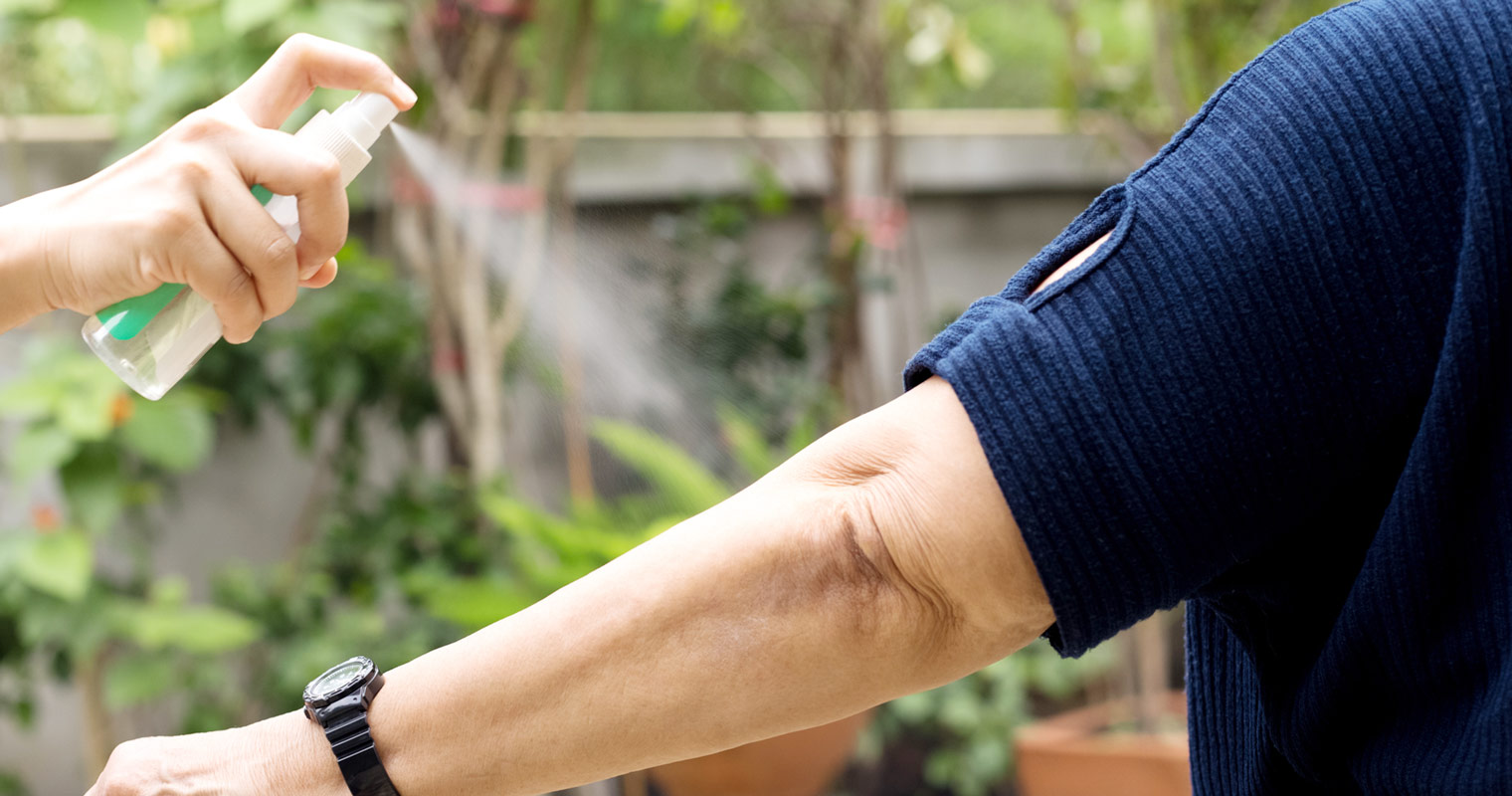Singapore is teeming with insects.
They make up a much bigger part of our biodiversity than most of us might imagine – it has been estimated that there may be well over 10,000 species of beetles alone in just the Bukit Timah area. They are simply everywhere – not just in parks, fields, reservoirs and swathes of jungle, but in the corners of our homes, schools, office buildings, and more as well.
As necessary and even beneficial as these creatures may be to the balance of our ecosystem, insects are often regarded as pests by humans, something to be exterminated due to the illness or inconvenience they bring. An unwanted encounter with a bug might leave us with itchy bites or worse – venomous stings or, in the worst of scenarios, dangerous and life-threatening diseases such as dengue fever or the Zika virus.
With the potential risks that are out there, investing in a good insect repellent becomes a matter not just of comfort, but of your health and safety. In this article, we break down some important information about common insects in Singapore, what to do if you get bitten or stung by an insect, as well as the various kinds of insect repellents out there so that you can make an informed decision on the best way to avoid bites and stings.

Five common insects found in Singapore, and how to deal with them
Listed below are five insects commonly found in Singapore, all of which can bite or sting. Details on how to prevent and treat these bites and stings can be found under each sub-section.
1. Mosquitoes
Mosquitoes are notorious worldwide as a carrier of deadly diseases such as malaria, dengue, zika and chikungunya. In Singapore, the main public health and safety issue related to mosquitoes is the spread of dengue fever and the zika virus. It’s therefore important to ensure that we make our living environment as unconducive to the breeding of mosquitoes as we possibly can, to avoid a burgeoning mosquito population that could facilitate the wider and faster spread of disease. One of the ways you can attempt to eliminate mosquito breeding zones in your household is to follow the National Environmental Agency’s “5-Step Mozzie Wipeout”; as the Aedes mosquito prefers to breed in clean, stagnant water, ensure that you empty stagnant water from around your home such as in flower pot plates, vases, bowls, garbage bags, and water storage containers.
In addition, many Singaporean families also rely on mosquito coils or plug-in repellents to keep mosquitoes away, ensuring that there are no mosquitoes seeking out a breeding ground within the home, to begin with.
As for repellent products for the body, there is a great variety available, such as citronella patches, to be worn on clothes, and repellent sprays – it is a matter of choosing what you are most comfortable with using.
If you happen to display one or more of the following symptoms after having been bitten by a mosquito, you should seek immediate medical attention as you may have been exposed to serious mosquito-borne illnesses:
- Nausea
- Fever
- Aches and pains
- Rashes
Mosquito bites are generally not harmful to such a large extent, though they can be extremely itchy – it is not uncommon to see individuals scratching their mosquito bites so vigorously and aggressively that they break the skin and bleed from the bitten area. This is not recommended as it can lead to infection and scarring – instead, try calamine lotion or a soothing ointment.

2. Sandflies
Many a nice trip to the beach has been blighted by the extensive sandfly bites that tend to follow. Though the bites, which turn into red bumps, are known to be extremely itchy and can be very painful, it’s best not to scratch them as this can make the affected area swell even further. There are several commonly suggested home treatments to provide relief from these bites, such as the application of fresh aloe vera juice, baking soda, apple cider vinegar, diluted tea tree oil, or very hot water to the affected area several times a day. Though the efficacy of such treatments has not been medically tested or proven, many Singaporeans swear by them when it comes to dealing with sandfly bites – perhaps there might be some as-yet-undiscovered mechanisms that make these treatments so effective.
As for preventing sandfly bites, some beachgoers are wary of using repellents due to their potential toxic effect on marine life. If you aren’t comfortable with the idea of using a repellent product the next time you are at the beach, the next best thing to do would be to wear clothes that cover up most of your skin, such as pants, jeans and long-sleeved shirts – though depending on your reasons, this might entirely defeat the purpose of your decision to visit the beach.
3. Ants
There are several common varieties of ant in Singapore, such as the black ant, fire ant and pharaoh’s ant. The black ant is probably the most immediately visually recognisable to most Singaporeans as they are commonly found in homes, particularly in kitchens where sugar and sweet foods are abundant. Though these ants are not as aggressive as some other species, take note that they can be a carrier of diseases such as salmonella and hence can still pose a health and safety risk. In order to avoid attracting ants to your home, store sugar and sweet foods in properly-sealed containers, and keep surfaces clean and free of food particles.
Out of the ant species in Singapore, the fire ant is undoubtedly the most aggressive; the stings that they inflict are painful, described by some as a ‘burning sensation’, and cause pustules to appear on the surface of the skin. Cold compresses are recommended to relieve the pain and swelling caused by fire ant bites, and antihistamine cream is usually sufficient to treat the pustules.
4. Bees
The types of bees found in Singapore, such as honeybees and bumblebees, are generally not aggressive and do not sting unless they have been provoked or feel threatened. However, bee venom can be rather deadly – it has the potential to trigger an allergic reaction, causing the victim to go into anaphylactic shock, which can have fatal consequences. Therefore, it is imperative that anyone who is allergic to bee venom seek immediate medical attention if they get stung by a bee.
5. Wasps
Visually, wasps may share some similarities with bees, making it difficult to tell whether you are encountering one or the other. How can you differentiate a wasp from a bee? In general, wasps tend to have a more ‘streamlined’ look, with narrower bodies, and while bees can have a hairy or fuzzy appearance, wasps do not. Wasps also tend to have hives that look like paper lanterns, rather than the characteristic honeycomb look of a hive run by bees.
Wasps are more aggressive and defensive than bees – therefore, it is important to avoid provoking or agitating them if you encounter a swarm of wasps; attempt to stay calm as much as possible, without flailing or attempting to swat them away. Just as with bee stings, it is possible for victims to have allergic reactions to wasp venom, although this is rare. In such cases, medical attention should be sought immediately. In all other cases, a cold compress, painkillers, and antihistamines (which reduce the swelling of the affected area) are recommended to relieve the pain of a wasp sting.
What to do if you get bitten or stung
Given the sheer number of insects around, it is almost inevitable that you might have an unpleasant encounter with any one of the insects mentioned above at some point. In general, insect bites do not cause serious issues, nor do they require medical attention most of the time. The most important thing to take note of is that it would be wise not to scratch any bites, stings or pustules as this could potentially lead to infection of the bitten or stung area.
However, experts advise that you should seek immediate medical attention if you are allergic to insect venom (for example, the venom of wasps, bees or fire ants) or experience symptoms such as nausea, stomach pain or breathing difficulties after getting bitten or stung by an insect, or if the bite or sting shows signs of infection.

How to prevent unpleasant encounters with insects
Learning to spot and avoid the nests and common breeding grounds of the most bothersome insects is invaluable in eluding any undesirable encounters with the insects mentioned. Investing in repellent products for the home is also an important step in trying to stay protected at all times. And of course, one of the best ways to avoid any nasty experiences with insects wherever you go is simply to remember to apply insect repellent when you leave the house. This is particularly if you’ll be spending lots of time outdoors. In order to maximise the efficacy of your insect repellent, be sure to read all directions and precautions, to use not less than the amount of product specified, and to try to avoid extensive exposure to water.
Differences between natural & synthetic repellents
There are, however, some health concerns related to several ingredients in typical commercial insect repellent formulations. Some, such as picaridin, are of relatively low toxicity, with the potential to cause skin irritation in some users. Most infamous for the health concerns that have come to be associated with it is the chemical diethyltoluamide, abbreviated as DEET, is one of the most common ingredients in commercial insect repellent formulations. It has been reported that exposure to DEET can cause respiratory problems, seizures, headaches, and a burning sensation in the eyes, amongst other issues. Commercial insect repellents are commonly made up of at most 30% DEET. Though insect repellents containing DEET are still reported by some sources to be safe for use and are widely available for purchase, you might want to err on the side of caution and avoid products containing this chemical. Look for gentler formulations that are DEET-free or that have a lower concentration of DEET; products with a lower percentage of DEET in the formula are actually equally effective at repelling insects, though this effect lasts for a shorter period of time.
If you’re concerned about the potentially harmful effects of the ingredients in commercial insect repellents, you might be relieved to know that there are several effective natural alternatives to such products. Here are three you may or may not have heard of:
Citronella oil
Studies have shown that citronella oil is an effective repellent against mosquitoes. The multitude of insect repellent products out there featuring citronella oil is a testament to its effectiveness and popularity with consumers. One study has also found that when combined with vanillin, a naturally-occurring sweet-smelling chemical often used in flavourings and fragrances, the repellent effects of citronella are prolonged.
Lemongrass oil
In a study conducted on the repellency of certain types of essential oils against sandflies, it was found that lemongrass essential oil was highly repellent, causing a sharp decrease in biting rates upon application. This oil has also been found to exhibit protection against the Aedes mosquito, a carrier of the deadly dengue virus.
Clove oil
Several studies show that this spicy-smelling oil is an effective repellent against many types of insects such as Aedes mosquitoes, wasps, and fire ants.

Other essential oils noted for their highly effective insect repellency are geranium, cinnamon, and lemon eucalyptus. The studies mentioned above tested the essential oils usually through the application of diluted essential oils to the skin. Take note, however, that diluting your own essential oils is not recommended; these oils are extremely potent and concentrated, and improper dilution can cause skin irritation and even chemical burns, doing you more harm than good. If you’d like to harness the potency of these oils in the form of an insect repellent for dermal application, it would be safer to seek out a commercial repellent made with these ingredients than to attempt to blend one at home.
However, if you do have any of these essential oils on hand, you can still utilise their insect-repelling properties for the home without the need for special or expensive equipment such as diffusers and coils. Speaking from personal experience, dipping unused perfume test strips into these essential oils and placing several of these strips in affected rooms or parts of the house was a surprisingly effective way of repelling mosquitoes. The same effect could be achieved using other kinds of stiff paper or card, for instance.
Repellents for children vs. repellents for adults
Getting bitten or stung by an insect can be a highly distressing experience for a child and could cause them to develop an unhealthy of the specific species they had a bad encounter with, or of insects in general. While it is important to protect your child from such experiences, and while insect repellent may play a significant role in this, there are some more considerations when it comes to the use of insect repellents on children.
For instance, worrying as the harmful effects of DEET, as mentioned in an earlier section of this article, seem to be, it is important to note that DEET has been found that to be especially toxic to children; in one study, exposure to DEET was linked to increased rates of encephalopathy – a general term referring to disease and damage to the brain – in children. Yet, it is indisputable that children are also more vulnerable to insect-borne diseases due to the fact that their immune systems are not yet fully developed. To take no measures to prevent bites and stings would not be good for your child, either.
Because of the potential health risks that exposure to DEET poses to children, alternative formulations containing either picaridin or natural essential oils might be a safer option, with the only drawback being their drastically shorter duration of efficacy – such formulations supposedly have less than 10% of the duration of action than a formula containing DEET.
If you have found an insect repellent formulation that you are comfortable using on your child, follow these guidelines to ensure proper application, and be sure to teach your child how to apply insect repellent properly as well:
- Do not apply insect repellent to children younger than 2 months of age.
- Follow the product’s directions in order to ensure you apply the correct amount of product.
- Do not apply the insect repellent in an enclosed area or an area that is poorly ventilated.
- Do not apply the insect repellent on broken or irritated skin.
- Do not spray repellent directly onto the face – apply it on hands first, using the hands to spread the product onto the face.
- Avoid the eyes and mouth when applying repellent to the face.
- Do not breathe in the product as it is being applied – or indeed, in general.
- Do not apply repellent to skin that is already covered by clothing, only to skin that will be exposed.
- Do not let small children handle the product themselves, and do not apply it on their hands. This precaution is due to the fact that young children have a tendency to rub their eyes with their hands or to put their hands in their mouths.
- Remind older children to wash their hands after applying the repellent on themselves – and wash your own hands after applying repellent on children.
- Additionally, just as with other chemical products, do not forget to keep insect repellent products securely out of the reach of children when not in use.

If you find yourself still feeling uncomfortable with the idea of your child being exposed to insect repellent, be it DEET free or not, there are still some other ways in which you can try to minimise the possibility of your child being bitten or stung by insects, listed below:
- As it is said that strongly-scented personal care products such as soaps, lotions and perfumes can attract certain kinds of insects, you may find it worthwhile to invest in fragrance-free products for your child, or to get them to avoid using these products on days when they are likely to be engaged in activities that expose them to insects.
- Teach your child to identify and avoid nests, hives, common breeding sites (such as stagnant water collected in garbage disposal areas) and areas where many insects can be found.
- Teach your child to dress in attire that doesn’t leave their skin exposed and vulnerable to insects, such as pants and long-sleeved shirts, when they are going somewhere where they will be exposed to insects for long periods of time such as the beach or outdoor school camps.
Although dealing with insect bites and stings might be unpleasant and a source of irritation, these generally do not pose a threat to one’s health and safety. And especially considering the wide range of effective insect repellents available today in countless formats, dealing with insect bites and stings is largely a matter of prevention rather than cure.
Having found out a little bit more about your options when it comes to protection from insects, you’ll find yourself better equipped to make informed decisions on the types of insect repellents you wish to use on yourself and your loved ones.
References
https://www.nss.org.sg/documents/Pages%2029-39%20Cheong,%20L%20F.,%202013.%20Insect%20Conservation%20in%20Singapore.pdf
http://www.tnp.sg/news/singapore-news/5-step-mozzie-wipeout
http://wildshores.blogspot.se/2009/08/sandflies-bane-of-our-shores.html#.Wt8H7ohubIU
https://www.rentokil.com.sg/ants/species/
https://www.ncbi.nlm.nih.gov/books/NBK470576/
https://www.rentokil.com.sg/bee-wasp-hornet/stings/
http://www.gpfirst.sg/common-medical-conditions.php?val=9
http://www.wemjournal.org/article/S1080-6032(15)00434-2/fulltext
https://www.ncbi.nlm.nih.gov/m/pubmed/11339626/
https://pdfs.semanticscholar.org/88ca/a4cc2a66d8d8a7133d90bc6f3300546293c0.pdf
https://www.ncbi.nlm.nih.gov/pubmed/21481108
https://www.ncbi.nlm.nih.gov/pmc/articles/PMC4027311/ https://www.ncbi.nlm.nih.gov/m/pubmed/23448024
https://www.ncbi.nlm.nih.gov/pmc/articles/PMC5459757/
https://onlinelibrary.wiley.com/doi/pdf/10.1111/j.1365-3156.2011.02781.x
https://www.epa.gov/insect-repellents/using-insect-repellents-safely-and-effectively#children







